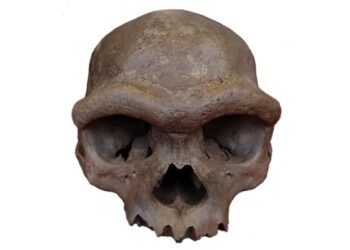A new radiocarbon dating analysis has finally settled one of archaeology’s most contentious debates: when the massive eruption of Thera (Santorini) volcano occurred in relation to the dynastic timeline of ancient Egypt. The research, published in PLOS ONE by an international team of scientists from Ben-Gurion University of the Negev and the University of Groningen, concludes that the Minoan eruption occurred before Pharaoh Ahmose I, the founder of Egypt’s 18th Dynasty.

The Thera eruption, one of the largest eruptions of the last 10,000 years, devastated the Minoan civilization, buried the city of Akrotiri, and caused tsunamis across the Aegean and the eastern Mediterranean. Researchers have sought to link this event to Egyptian history for decades. Some believed it coincided with the early New Kingdom and linked it to the “Tempest Stela” of Ahmose, which describes dark skies and violent storms.
But the new research indicates that the eruption occurred before Ahmose’s reign, and instead positions it in the Second Intermediate Period — a fragmented era before Egypt was reunited. This eliminates the possibility that the tempest described by Ahmose was caused by Thera’s volcanic cloud.

To resolve the dispute, Professors Hendrik J. Bruins and Johannes van der Plicht obtained rare permission to analyze Egyptian artifacts kept at the British Museum and the Petrie Museum in London. They analyzed a mudbrick stamped with Ahmose’s throne name, Nebpehtyra, from his temple at Abydos, a linen burial cloth of Queen Satdjehuti, and various wooden shabtis from Thebes dating to the 17th Dynasty.

The researchers took a sample of fresh straw used in making the mudbrick and dated it accurately. Radiocarbon dating of the straw and one of the shabtis indicates that Ahmose reigned later than previously thought — around 1539 BCE, rather than near 1580 BCE. This supports a “low chronology” for the beginning of the New Kingdom.
Comparing these new Egyptian dates with established and uncalibrated radiocarbon dates for Thera — including samples from Akrotiri’s carbonized seeds, an olive tree buried in ash, and animal bones from tsunami layers in Crete — revealed that all Thera samples are older. The eruption, therefore, occurred decades before Ahmose’s reign and the founding of the 18th Dynasty.

This finding not only negates the Tempest Stela theory but also extends the estimated length of the Second Intermediate Period. It is consistent with previous genealogical studies showing that the transition of Egypt from the Middle to the New Kingdom took more time than was previously supposed.
The study demonstrates how radiocarbon dating can balance geological and historical chronology. By linking Egypt’s artifacts with volcanic evidence, scientists have finally resolved an argument that dragged on for generations. The Thera eruption, which was long thought to coincide with Egypt’s New Kingdom, actually occurred before it — a catastrophe that reshaped the Aegean world centuries before Pharaoh Ahmose began Egypt’s golden age.























Thank you, the Amouse sculpture seems broke nose processed by professional, although Ancient Egyptians are known as African History.
What are you even talking about bro?
Abolutely extraordinary !
I doubt that this paper will end the dispute about when Thera erupted, historically. Followers of the New Chronology of David Rohl argue the current New Kingdom dates are wrong, with Ahmose’s reign starting about 1190 BC. A first eruption of Thera lead to the Hyksos retreating to the Gaza area about 1181 BC. The massive eruption of Thera then occurs late in Thutmose 111’s reign, about 1,100 BC. This coincides with a large H2SO4 peak in an ice core from Greenland. David Rohl contends that Dynasties 18,19 and 20 are wrongly dated, and should be dated about 300 odd years lower than at present. This gives a much more integrated “history” than at present. Get the history right, then see if radio carbon agrees with it!
1181? Nonsense! The Thera eruption is dated 1600 B.C.